
Growing a palm tree in a pot
Exoticism on the balcony!
Contents
You may have various reasons for growing a palm in a pot: to elegantly decorate your terrace, to bring some exotic flair to your dreary balcony, or to enhance your courtyard… Palms are decorative, easy to grow, evergreen, and always lush. They are not limited to Mediterranean climates, and growing a palm in a pot is entirely possible in many regions, provided you follow a few tips regarding the choice of palm, the type of pot and substrate, planting, and maintenance. Let us guide you; we’ll explain everything!
Which species and varieties of palms are suitable for pot cultivation?
Palms that will thrive in pots, and thus remain beautiful throughout the seasons, are the smaller varieties. It would indeed be foolish to attempt to pot or containerise a specimen that would normally reach an adult height of over 10m! The category of dwarf palms offers beautiful specimens and a choice for all tastes: large fan-shaped leaves or long palmate stems, trunks—referred to as stipes in palms—that are short or slender. However, what should guide your choice first and foremost is their hardiness. Indeed, depending on your region, winters could be fatal for your potted palm, especially since in a container, the root ball and root system are less protected than in the ground. Here is a selection of palms suitable for pot cultivation, classified according to hardiness criteria.
The most hardy
- The Needle Palm, Rhapidophyllum hystrix, is a very hardy small palm (down to -20°C) with a distinctly ornamental and exotic appearance. It enjoys well-drained soils and prefers shade. Its large, deeply lobed fan-shaped leaves are a beautiful dark glossy green. Its common name comes from the small needles present at the base of its leaves. This species is one of the best palms to grow in pots, given its cold resistance and small size. It will add an exotic charm to a shaded courtyard or city garden, or to a balcony that only sees the sun for a few hours a day.
Chamaerops: hardy to -10°C
- Chamaerops humilis ‘Compacta’: As its name suggests, this palm has a compact habit, well-suited for pot cultivation. It is quite hardy, tolerating negative temperatures of around -10 to -12°C in well-drained soil. Its numerous stems bear beautiful wide palmate leaves arranged in a fan shape. The stipe is covered in fibres. Like all Chamaerops, it prefers full sun and adapts perfectly to drought and poor soils.
- Chamaerops humilis ‘Vulcano’: A must-have, this palm resembles the previous one with the same cold resistance and growing conditions, but with grey-green foliage. It is also well-suited for pot cultivation.
- Chamaerops humilis ‘Cerifera’: Similar characteristics to the previous varieties, with stunning blue-tinged foliage!
Hardy palms to -5°C
- Cycas revoluta: This is actually a shrub, a living fossil, with a beautiful palm-like silhouette, bearing a crown of glossy, stiff leaves on a short, swollen trunk. The cycas has a slow growth rate, making it an excellent choice for pot cultivation. It is very drought-resistant and tolerant of sea spray, so it will easily find a place on a terrace in a seaside garden!
- The Formosan Palm Arenga englerii: A lovely palm also ideal for pot cultivation due to its small size. It forms one or more slender dark-coloured stipes, topped with long, narrow fronds that are a beautiful green with a white-silver underside. In the ground, it is hardy down to -7°C, slightly less so in pots.
- Chamaedorea klotzschiana: This palm has a bamboo-like appearance with slender stems forming stipes with cream-coloured rings. Provide it with a light growing medium that remains slightly moist.
Frost-sensitive palms: to be taken out only in the warm season
These dwarf palms thrive in pots, but their low cold resistance makes them more suitable for indoor or conservatory cultivation, to be placed on your terrace or balcony when frosts are no longer a concern, from May to September.
- The Ernest August Palm Chamaedorea ‘Ernesti-augusti’
- The Australian Palm Oraniopsis appendiculata
- The Dwarf Date Palm Phoenix roebelinii
- The Hawaiian Palm Pritchardia hillebrandii ‘Blue Moon’
- Fiji Palm Pritchardia pacífica
- The Fiji Fan Palm Pritchardia thurstonii
- The Florida Cherry Palm or Buccaneer Palm Pseudophoenix sargentii
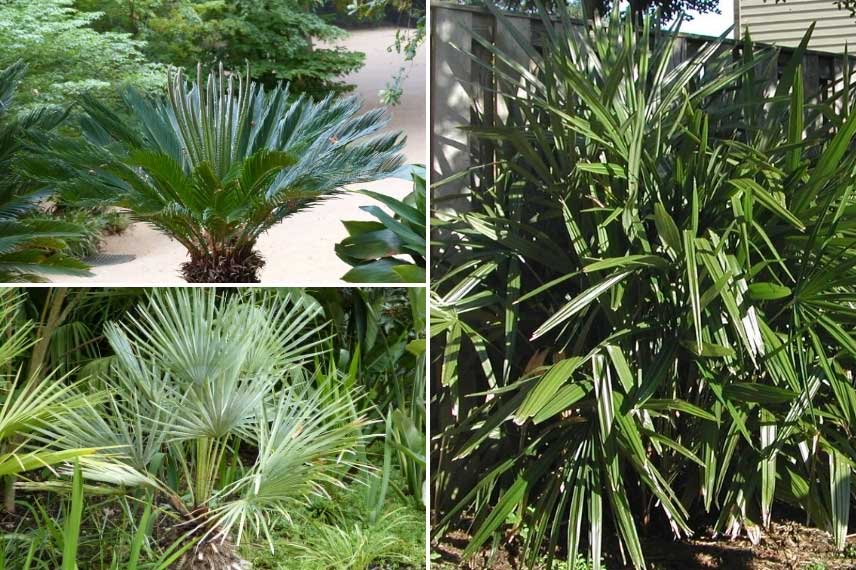
Cycas revoluta, Chamaerops humilis ‘Cerifera’ and Rhapidophyllum hystrix
Choosing the pot and substrate
The choice of pot is a matter of taste! Don’t hesitate to invest in fairly large pots: your palm will look even better. Consider the matching saucer that will sit under the pot. Terracotta has the advantage of being porous, allowing the substrate to breathe, and it regulates temperatures better. Wooden pots may have a shorter lifespan due to watering and root growth. Finally, plastic or resin pots are lighter but are not eco-friendly at all. Match the style of the pot with the style of your home: a lovely stone farmhouse does not pair well with colourful graphic resin pots, and classic Anduze vases may not fit very well into a sleek, modern decor. To each their own taste, to each their own style! The palm, however, integrates very well into any style of decor.
What is important is the substrate in which your palm will be planted. Palms generally prefer rich, light soils: choose a light potting mix for balconies and terraces or a potting mix for citrus trees and Mediterranean plants.
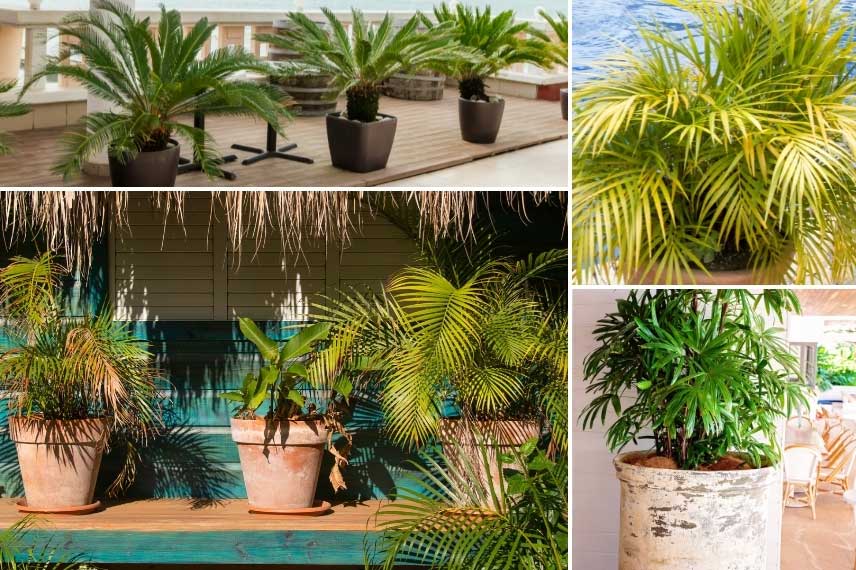
Different types of pots for palms
Discover other Palm trees
View all →Available in 5 sizes
Available in 1 sizes
Available in 1 sizes
Available in 1 sizes
Available in 1 sizes
Available in 4 sizes
Available in 2 sizes
Available in 1 sizes
Available in 1 sizes
Planting tips
Once you have chosen the palm and the pot, it’s time for planting:
- Start by filling the bottom of the pot with clay balls to a depth of 2 to 5 cm to promote drainage, preventing water from stagnating and causing the roots to rot.
- For Cycas revoluta, the substrate should ideally be mixed with pumice, crushed brick, or another porous material. Arenga englerii thrives in rich, humus-bearing soils.
- Plant your dwarf palm in its pot, filling with potting soil, and remember to gently untangle any root ball that may have formed beneath the clump.
- Cut off any dried leaves, keeping only the healthy green ones.
- Firm the soil well, water, and spread an organic (bark) or mineral (pumice, clay balls, gravel, or pebbles) mulch on top to retain moisture in the substrate and enhance its appearance…
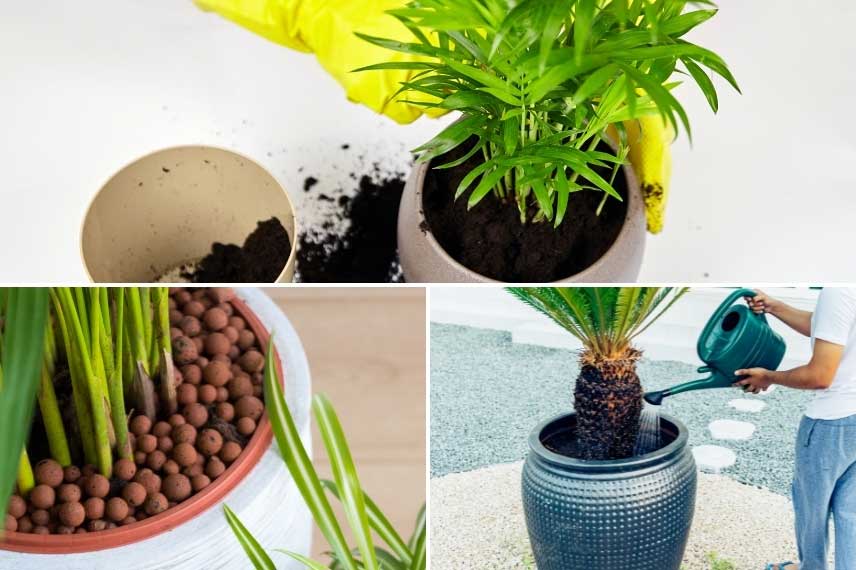
Planting the palm in a pot
Exposure and location
Not all the palms mentioned will have the same needs regarding sunlight exposure: some prefer full sun, as one might expect from palms, while others will prefer partial shade or may not tolerate sunlight at all.
Palms for full sun
- Cycas revoluta: full sun and bright light, even partial shade.
- Chamaerops humilis ‘Compacta, Chamaerops humilis ‘Compacta and Chamaerops humilis ‘Compacta’
- Phoenix roebelinii
- Pritchardia hillebrandii ‘Blue Moon’
Palms for partial shade
- Arenga englerii
- Chamaedorea klotzschiana
- Oraniopsis appendiculata
- Pritchardia hillebrandii ‘Blue Moon’
- Pseudophoenix sargentii
Palms for shade
Caring for potted palms
When to water a potted palm?
Potted palms need regular watering. Ensure this water supply, especially during the warm season, and allow the substrate to dry out a bit between waterings. Avoid stagnant water in the pot saucers. Rhapidophyllum hystrix, true to its undergrowth bush temperament, will appreciate a compost addition 1 to 2 times a year. To successfully grow Chamaerops, provide them with regular watering in summer.
Don’t hesitate to give it a little boost with special palm fertiliser. Note that Cycas revoluta loves frequent repotting. It will thank you by growing faster, with beautiful foliage.
Be careful, it is susceptible to mealybugs.
- Subscribe!
- Contents


































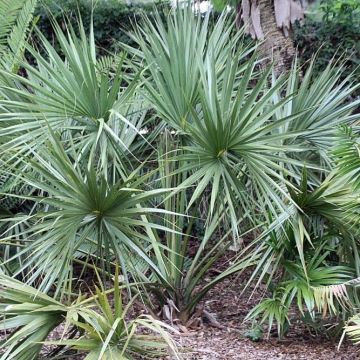

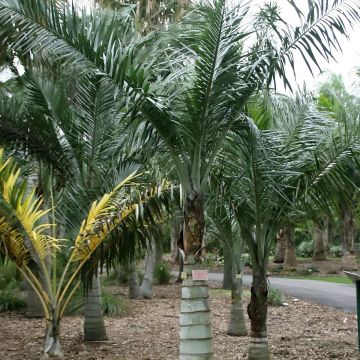

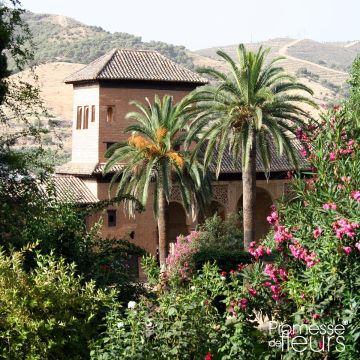
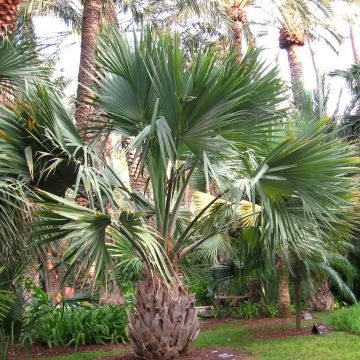


Comments